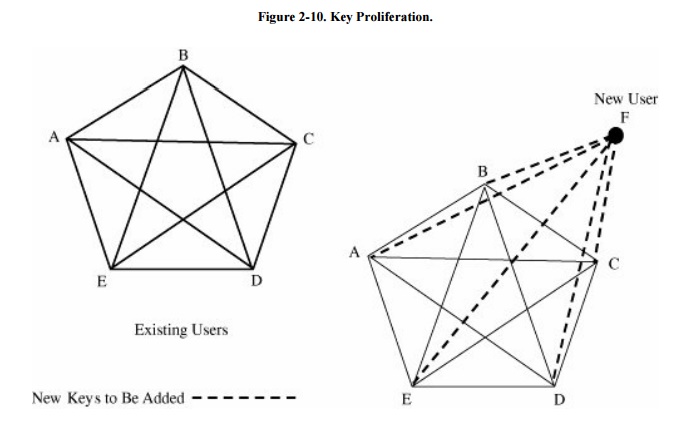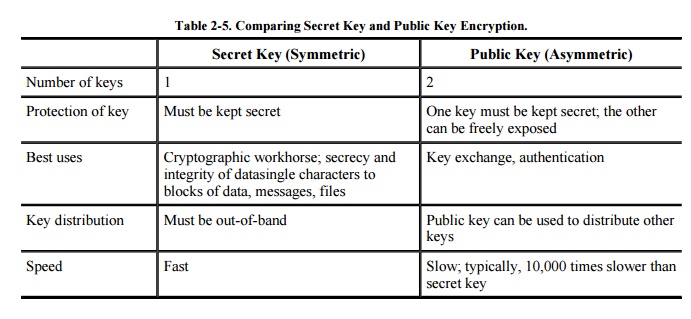Chapter: Security in Computing : Elementary Cryptography
Public Key Encryption
Public Key Encryption
So far, we have looked at
encryption algorithms from the point of view of making the scrambling easy to
do (so that the sender can easily encrypt a message) and the decryption easy
for the receiver but not for an intruder. But this functional view of
transforming plaintext to ciphertext is only part of the picture. We must also
examine the role of keys in encryption. We have noted how useful keys can be in
deterring an intruder, but we have assumed that the key must remain secret for
it to be effective. In this section, we look at ways to allow the key to be
public but still protect the message. We also focus on the RSA algorithm, a
public key system that is a popular commercial-grade encryption technique.
In 1976, Diffie and Hellman proposed a new kind of encryption system.
With a public key encryption system, each user has a key that
does not have to be kept secret. Although counterintuitive, in fact the public
nature of the key does not compromise the secrecy of the system. Instead, the
basis for public key encryption is to allow the key to be divulged but to keep
the decryption technique secret. Public key cryptosystems accomplish this goal
by using two keys: one to encrypt and the other to decrypt.
Motivation
Why should making the key
public be desirable? With a conventional symmetric key system, each pair of
users needs a separate key. But with public key systems, anyone using a single
public key can send a secret message to a user, and the message remains
adequately protected from being read by an interceptor. Let us investigate why
this is so.
Recall that in general, an n-user system
requires n * (n - 1)/2 keys, and each user must track and remember a key for
each other user with which he or she wants to communicate. As the number of
users grows, the number of keys increases very rapidly, as shown in Figure 2 -10. Determining and distributing these
keys is a problem. More serious is maintaining security for the keys already
distributed, because we cannot expect users to memorize so many keys.

Characteristics
We can reduce the problem of
key proliferation by using a public key approach. In a public key or asymmetric encryption system, each user
has two keys: a public key and a private key. The user may publish the public
key freely because each key does only half of the encryption and decryption
process. The keys operate as inverses, meaning that one key undoes the
encryption provided by the other key.
To see how, let kPRIV be a user's
private key, and let kPUB be the corresponding public key. Then,
encrypted plaintext using the public key is decrypted by application of the
private key; we write the relationship as
P = D(kPRIV, E(kPUB, P))
That is, a user can decode
with a private key what someone else has encrypted with the corresponding
public key. Furthermore, with some public key encryption algorithms, including
RSA, we have this relationship:
P = D(kPUB, E(kPRIV, P))
In other words, a user can encrypt a message
with a private key, and the message can be revealed only with the corresponding
public key.
These two properties tell us
that public and private keys can be applied in either order. In particular, the
decryption function D can be applied to any argument so that we can decrypt
before we encrypt. With conventional encryption, we seldom think of decrypting
before encrypting. But the concept makes sense with public keys, where it
simply means applying the private transformation first and then the public one.
We have noted that a major
problem with symmetric encryption is the sheer number of keys a single user has
to store and track. With public keys, only two keys are needed per user: one
public and one private. Let us see what difference this makes in the number of
keys needed. Suppose we have three users, B, C, and D, who must pass protected
messages to user A as well as to each other. Since each distinct pair of users
needs a key, each user would need three different keys; for instance, A would
need a key for B, a key for C, and a key for D. But using public key
encryption, each of B, C, and D can encrypt messages for A by using A's public
key. If B has encrypted a message using A's public key, C cannot decrypt it,
even if C knew it was encrypted with A's public key. Applying A's public key
twice, for example, would not decrypt the message. (We assume, of course, that
A's private key remains secret.) Thus, the number of keys needed in the public
key system is relatively small.
The characteristics of secret key and public key algorithms are compared in Table 2-5.

RivestShamirAdelman Encryption
The RivestShamirAdelman (RSA) cryptosystem is a public key system.
Based on an underlying hard problem and named after its three inventors, this
algorithm was introduced in 1978 and to date remains secure. RSA has been the
subject of extensive cryptanalysis, and no serious flaws have yet been found.
Although the amount of analysis is no guarantee of a method's security, our
confidence in the method grows as time passes without discovery of a flaw.
Let us look at how the RSA
encryption scheme works; we investigate it in greater detail in Chapter 12. RSA relies on an area of mathematics
known as number theory, in which mathematicians study properties of numbers
such as their prime factors. The RSA encryption algorithm combines results from
number theory with the degree of difficulty in determining the prime factors of
a given number. As do some of the other algorithms we have studied, the RSA
algorithm also operates with arithmetic mod n.
The two keys used in RSA, d
and e, are used for decryption and encryption. They are actually
interchangeable: Either can be chosen as the public key, but one having been
chosen, the other one must be kept private. For simplicity, we call the
encryption key e and the decryption key d. Also, because of the nature of the
RSA algorithm, the keys can be applied in either order:
P = E(D(P)) = D(E(P))
(You can think of E and D as
two complementary functions, each of which "undoes" the other.)
The encryption algorithm is based on the
underlying problem of factoring large numbers. So far, nobody has found a
shortcut or easy way to factor large numbers in a finite set called a field. In
a highly technical but excellent paper, Boneh reviews all the known cryptanalytic attacks on RSA and concludes that none is
significant. Because the factorization problem has been open for many years,
most cryptographers consider this problem a solid basis for a secure cryptosystem.
Related Topics